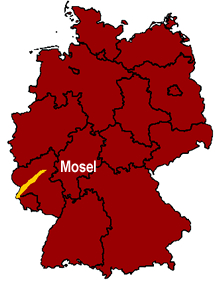Mosel Wine Region
Also known as: Mosel-Saar-Ruwer Wine Region. The name of this region was changed officially to "Mosel" in Fall 2007. Wines bottled before this time still reflect the old name, "Mosel-Saar-Ruwer."
Location
The Mosel wine region is located mostly in the German state of Rhineland-Palatinate (Rheinland-Pfalz) with a little portion in the state of Saarland. It runs 145 miles (242 km) along the Mosel River (from Germany's border with Luxumbourg to the city of Koblenz) and its side-shoots, the Saar and Ruwer Rivers.
Size
Germany's fifth largest wine region.
22,217 acres (8,991 hectares)
5,258 wineries in 125 towns
22,190,448 gallons (840,000 hectoliters) of wine are produced annually in the Mosel region (31.4% Prädikatswein; 67.8% Qualitätswein bestimmter Anbaugebiete, 0.8% Tafelwein). This accounts for 9% of the volume from Germany's entire wine region.
Climate & Geography
The Mosel wine region has ideal conditions for grapes to thrive. The vineyards are built on extremely steep hillsides, which allows grapevines to get great exposure to sunlight. The grapes benefit from additional sun rays that are reflected off the rivers. The soil consists of lime scale and weathered slate. The region receives the optimal amount of precipitation.
Grape Varieties
In no other place in the world is so much area dedicated to the Riesling grape: 13,650 acres (5,523 hectares). It is the Mosel's most important grape, with the Müller-Thurgau being a distant second. The Mosel's most important grapes are listed below.
Characteristics of Mosel Wine
Mosel Riesling wines are very fragrant, rich in acidity and fruity flavors, and often with mineral undertones. The wines from the Ruwer Rivery valley tend to be the most fragrant, often with sharp acidity. Those from the Saar River valley are also acidic. The wines from along the Mosel are the softest and fullest of the region. Overall, wines from this region, ranging from dry to sweet, are considered top quality.
History
Wine production in the Mosel region dates back to the 1st century BC when the Romans established vineyards here.
Additional Facts about the Mosel Wine Region
The following characteristics are found only in this wine region.
| • |
Trier, Germany's oldest Roman city. |
| • |
Germany's oldest vineyards |
| • |
The world's largest area (12,355 acres) covered by Riesling grapes. |
| • |
The world's steepest sloping vineyard. |
|


Photo: © beatuerk - Fotolia.com
|

